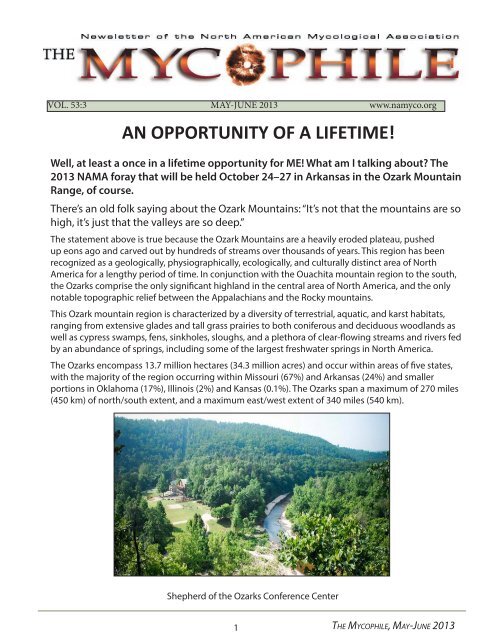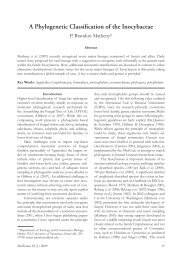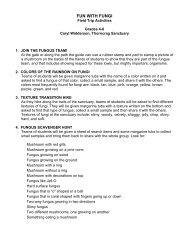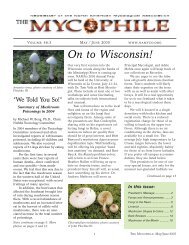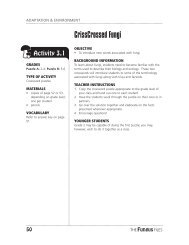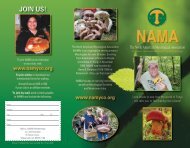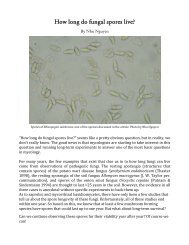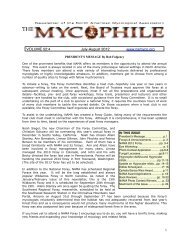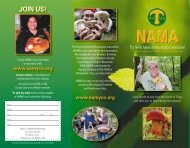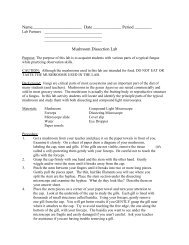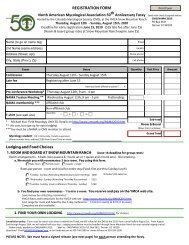The Mycophile 53:3 May/June 2013 - North American Mycological ...
The Mycophile 53:3 May/June 2013 - North American Mycological ...
The Mycophile 53:3 May/June 2013 - North American Mycological ...
Create successful ePaper yourself
Turn your PDF publications into a flip-book with our unique Google optimized e-Paper software.
VOL. <strong>53</strong>:3 MAY-JUNE <strong>2013</strong> www.namyco.org<br />
AN OPPORTUNITY OF A LIFETIME!<br />
Well, at least a once in a lifetime opportunity for ME! What am I talking about? <strong>The</strong><br />
<strong>2013</strong> NAMA foray that will be held October 24–27 in Arkansas in the Ozark Mountain<br />
Range, of course.<br />
<strong>The</strong>re’s an old folk saying about the Ozark Mountains: “It’s not that the mountains are so<br />
high, it’s just that the valleys are so deep.”<br />
<strong>The</strong> statement above is true because the Ozark Mountains are a heavily eroded plateau, pushed<br />
up eons ago and carved out by hundreds of streams over thousands of years. This region has been<br />
recognized as a geologically, physiographically, ecologically, and culturally distinct area of <strong>North</strong><br />
America for a lengthy period of time. In conjunction with the Ouachita mountain region to the south,<br />
the Ozarks comprise the only significant highland in the central area of <strong>North</strong> America, and the only<br />
notable topographic relief between the Appalachians and the Rocky mountains.<br />
This Ozark mountain region is characterized by a diversity of terrestrial, aquatic, and karst habitats,<br />
ranging from extensive glades and tall grass prairies to both coniferous and deciduous woodlands as<br />
well as cypress swamps, fens, sinkholes, sloughs, and a plethora of clear-flowing streams and rivers fed<br />
by an abundance of springs, including some of the largest freshwater springs in <strong>North</strong> America.<br />
<strong>The</strong> Ozarks encompass 13.7 million hectares (34.3 million acres) and occur within areas of five states,<br />
with the majority of the region occurring within Missouri (67%) and Arkansas (24%) and smaller<br />
portions in Oklahoma (17%), Illinois (2%) and Kansas (0.1%). <strong>The</strong> Ozarks span a maximum of 270 miles<br />
(450 km) of north/south extent, and a maximum east/west extent of 340 miles (540 km).<br />
Shepherd of the Ozarks Conference Center<br />
1<br />
<strong>The</strong> <strong>Mycophile</strong>, <strong>May</strong>-<strong>June</strong> <strong>2013</strong>
<strong>The</strong> prevailing tree community through most of the Ozarks consists of a variable deciduous wooded<br />
upland growing on leached acidic soils with abundant chert residue. Such woodlands are dominated<br />
by various species of oaks, such as white oak (Quercus alba), scarlet oak (Q. coccinea), blackjack oak (Q.<br />
marilandica), post oak, (Q. stellata) and Eastern black oak (Q. velutina). Associated with these oaks is an<br />
assortment of hickories such as pignut hickory (Carya glabra), black hickory (C. texana) and mockernut<br />
hickory (C. tomentosa), as well as a diversity of other trees, notably flowering dogwood (Cornus florida)<br />
and black gum (Nyssa sylvatica).<br />
Although books and articles have been written about much of the biota that occurs within this region,<br />
there has not been any extensive inventory of macrofungi in this area. So the potential for finding<br />
interesting and unusual mushrooms during the course of this foray is indeed great. We plan to collect<br />
macrofungi in several areas of the forests in the Southern Ozark Mountain range as well as at least one<br />
area within the Buffalo River National Park.<br />
<strong>The</strong> Shepherd of the Ozarks conference center will serve as the location for the <strong>2013</strong> NAMA foray. This<br />
location will allow us easy access to the southern perimeter of the Ozark Mountain Range. Lodging<br />
will be provided in nine on site lodges. <strong>The</strong> majority of these lodges are equipped with full kitchen<br />
appliances. Dining, mushroom identification and displaying of the mushrooms will all be done in one<br />
large building, the Buffalo Center.<br />
Shepherd of the Ozarks also provides some on site activities that non-mushrooming folks might<br />
enjoy. <strong>The</strong>se activities include: river tubing, fishing, sand pit volleyball, 9-hole disc golf, and for a fee -<br />
horseback riding, wilderness paintball, cliffhanging, laser tag, and navigating along some high ropes.<br />
I encourage anyone desiring additional information about Shepherd of the Ozarks to check out their<br />
web-site: http://www.sotocamp.com/<br />
<strong>The</strong> mycologists who have agreed to participate at this year’s NAMA foray include:<br />
Dr. Clark Ovrebo, mycologist and professor of biology at the University of Central<br />
Oklahoma, has agreed to serve as the foray’s chief mycologist. Clark has done<br />
extensive work with members of the genus Tricholoma and has recently done some<br />
field work on the Eastern edge of Brazil.<br />
Dr. Alan Bessette, mycologist and retired<br />
professor of botany from Syracuse<br />
University, and his wife Arleen Bessette,<br />
have authored or co-authored many well recognized<br />
mushroom field guides such as Mushrooms of <strong>North</strong>eastern<br />
<strong>North</strong> America, Mushrooms of the Southeastern United States,<br />
Milk Mushrooms of <strong>North</strong> America: A Field Identification Guide<br />
to the Genus Lactarius, Waxy Caps Mushrooms of Eastern <strong>North</strong><br />
America as well as <strong>North</strong> <strong>American</strong> Boletes.<br />
Dr. Andy Methven, mycologist and professor in the department of biological sciences at Eastern Illinois<br />
University, has co-authored several books with Michael Kuo. His current area of research is examining<br />
the distribution of Lactarius in the Western Hemisphere.<br />
Dr. Michael Kuo is the author or co-author of several mushroom field guides including Morels, 100<br />
Edible Mushrooms and 100 Cool Mushrooms. He also is the originator and web-master of that highly<br />
informative web-site that many of us visit from time to time, www.MushroomExpert.com.<br />
<strong>The</strong> <strong>Mycophile</strong>, <strong>May</strong>-<strong>June</strong> <strong>2013</strong> 2
Dr. Jean Lodge is a mycologist and botanist who works at the <strong>North</strong>ern Research Station, Sabana<br />
Station in Luquillo, Puerto Rica. She is a co-author on papers dealing with genera such as Cantharocybe,<br />
Pleurocollybia, Camarophyllus, as well as a newly described veiled Hygrocybe.<br />
Dr. Tom Volk is a well-known mycologist who has participated in many NAMA<br />
forays. He is currently professor of biology at the University of Wisconsin at La<br />
Crosse and has done research on many kinds of macrofungi including Armillaria,<br />
Laetiporus, as well as other wood-rotting fungi.<br />
Dr. Britt Bunyard is editor and publisher of Fungi<br />
Magazine and a co-author on a newly released<br />
mushroom field guide, Mushrooms and Macrofungi of Ohio and the Midwestern<br />
States.<br />
David Lewis, who has earned the title of “Magnificent<br />
Mycologist of Texas”, has done extensive field work in the<br />
Big Thicket National Preserve in Texas. David has four mushrooms bearing his last<br />
name including Cortinarius lewisii, Cantharellus lewisii¸ Pulveroboletus lewisii, and<br />
Russula lewisii.<br />
It’s going to be a great foray this year in Arkansas! <strong>The</strong><br />
scheduling of the foray for late October will assure that<br />
participants will not have to deal with high temperatures or<br />
humidity or ticks or chiggers. As an added bonus the leaves<br />
on the oak and hickory trees should be exhibiting<br />
some brilliant fall colors. Hope to see you in<br />
October!<br />
– Jay Justice, President of the Arkansas<br />
<strong>Mycological</strong> Society and Registrar for the<br />
NAMA <strong>2013</strong> foray.<br />
<strong>The</strong> registration form and waivers for the <strong>2013</strong><br />
NAMA Foray can be found on the last four pages of<br />
<strong>The</strong> <strong>Mycophile</strong>.<br />
See also: http://www.namyco.org/events/NAMA<strong>2013</strong>/index<strong>2013</strong>.html<br />
3<br />
<strong>The</strong> <strong>Mycophile</strong>, <strong>May</strong>-<strong>June</strong> <strong>2013</strong>
PRESIDENT’S MESSAGE<br />
Getting Down to Business at NAMA<br />
In my new role as president, I’ve been looking at the processes<br />
by which we function throughout the year. Treasury, Finance and<br />
Membership are our three mainstays, bringing in and maintaining<br />
our funds, and they work well. <strong>The</strong> committees — in particular Education,<br />
Toxicology, Photography and Cultivation — are popular<br />
destinations on the website. Planning for the annual and regional<br />
forays requires involvement and attention, which is the job of<br />
the Foray Committee. Several NAMA committees — Medicinal<br />
Mushrooms, Arts & Graphics, Mycophagy, Dyeing & Papermaking<br />
— could benefit from your expertise; please get involved and help<br />
design new programs.<br />
David Rust<br />
NAMA clearly needs more communication — with our affiliated<br />
clubs, regional trustees and non-affiliated members. <strong>The</strong><br />
<strong>Mycophile</strong> is our primary method of relaying information, although we also have a website, Facebook page<br />
and online discussion group. Developing more effective communication tools will be one of my goals in<br />
the coming year.<br />
As an association whose primary goal is to “promote, pursue and advance the science of mycology,” we can<br />
do more to develop programs, establish basic tools, and organize around scientific research. For example,<br />
take a quick look at the British <strong>Mycological</strong> Society (BMS) website: http://www.britmycolsoc.org.uk/. <strong>The</strong><br />
home page has three areas to investigate: Fungal Biology Research, Education and Outreach, and Field<br />
Mycology and Conservation. For decades, the BMS has trained their members to describe, photograph and<br />
publish new taxa. Articles are published in the BMS journal Field Mycology. This might serve as a model for<br />
our publication McIlvainea, to engage NAMA members in science and help mycology students get published.<br />
Conservation is an area we haven’t touched. In a time of changing climate and land development,<br />
we can serve science well by documenting what we have now.<br />
NAMA also needs to establish long-term planning and a better record of what we do year to year - key to<br />
growing the organization into our modern age. This is a subject you’ll be hearing much more about.<br />
I can report that we are in good shape financially; the last two forays were profitable and we have steady<br />
income from membership dues. Our fellowship endowment has surpassed the half way mark and is building<br />
steadily toward the goal of $100,000. <strong>The</strong> $2,000 NAMA memorial fellowship is awarded annually in<br />
conjunction with the <strong>Mycological</strong> Society of America to a promising graduate student in mycology.<br />
In the first three months of <strong>2013</strong>, I’ve looked at NAMA’s basic documents and business procedure with an<br />
eye toward strengthening our basic foundation. <strong>The</strong> Executive Committee is functioning and involved, and<br />
I consult frequently about budget and policy issues. I believe new financial controls are needed, as well as<br />
a more comprehensive description of Executive Committee role and responsibilities in the policy manual.<br />
If you have ideas or suggestions you’d like to share, please do so by email (david.rust@sbcglobal.net) or by<br />
phone 510-468-5014. <strong>The</strong> best suggestion I’ve heard so far, from Anna Gerenday, is creating a directory of<br />
mycological survey projects currently underway in <strong>North</strong> America. This would be a great addition to our<br />
website.<br />
NAMA’s <strong>53</strong> rd Annual Foray will be held this year in the Ozarks in Arkansas, October 24-27, <strong>2013</strong>. Join us<br />
there. It’s gonna be a good one!<br />
<strong>The</strong> <strong>Mycophile</strong>, <strong>May</strong>-<strong>June</strong> <strong>2013</strong> 4
SUPER IMMUNE SOUP<br />
by Chef Zachery Mazi<br />
This recipe combines herbs, both medicinal and culinary,<br />
with mushrooms, medicinal and culinary, and<br />
several broths, fresh vegetables, and coconut milk for<br />
a delicious and healthy soup.<br />
Mirepoix<br />
2 –3 T Coconut oil<br />
2 small leeks, cleaned and chopped<br />
1 large carrot, chopped small<br />
4 ribs celery, chopped small<br />
6 garlic cloves, broken and bruised<br />
6 inches ginger root, minced<br />
6 inches turmeric root, minced<br />
2 lemongrass stalks, broken and bruised<br />
Mushroom Blend<br />
1.5 lb. shiitakes, sliced and chopped<br />
6 oz. fresh oyster mushrooms<br />
1 small dry reishi mushroom, chopped<br />
8 Turkey Tail mushrooms, (3 oz) chopped<br />
Stock and Seasoning<br />
1 lime, quartered<br />
1 qt. mushroom stock<br />
1 qt. chicken broth<br />
1 gallon vegetable stock<br />
2 T Apple Cider Vinegar<br />
Finishing Ingredients<br />
2 cans Coconut Milk<br />
3 bunches baby bok choi, chopped1 bunch green<br />
onion, diced<br />
3T Coconut Aminos (like Bragg’s, but coconut; Coconut<br />
Secret)<br />
Salt to taste<br />
Herbal Tea<br />
2 oz. Echinacea root<br />
6 inches licorice root, broken<br />
3 cold and flu tea bags<br />
1 qt. water<br />
Sweat the mirepoix: Place coconut oil in heating stock<br />
pot, and add leek, carrot, celery, garlic, ginger, turmeric<br />
root, and lemon grass, and sweat (do not brown)<br />
until vegetables are softand aromatic. Add mushrooms,<br />
and stir quickly to coat with vegetable juices<br />
and coconut oil.<br />
Add the stock: Add all stocks, lime, and vinegar and<br />
increase heat to bring soup to a boil. When boiling, reduce<br />
to a simmer and cook for many hours to reduce<br />
liquid.<br />
Make the tea: Meanwhile, combine echinacea root,<br />
tea bags, and licorice root on low heat and brew for<br />
as long as desired. This will be added to the reduced<br />
soup later.<br />
Finish the soup: When soup is reduced to desired flavor<br />
(this will intensify), add herbal tea. the soup may reduce<br />
even more at this time, or you may remove from<br />
heat, add the coconut milk and bok choi, and season<br />
with salt and pepper, and coconut aminos.<br />
Before serving: Immediately before serving, add green<br />
onions. Note: <strong>The</strong> longer this soup steeps with the<br />
medicine, the better. Up to 12 hours. <strong>The</strong> soup may<br />
separate, but a good shake in a sealed container will<br />
bring it back together. As an option, you may remove<br />
the reishi mushroom, turkey tail, lemon grass and<br />
lime before serving, for ease of eating (sick people will<br />
appreciate this effort). This recipe makes1 gallon of<br />
soup.<br />
Snow Peas. Leeks.<br />
Shiitake Mushrooms.<br />
A quick and delicious Asian inspired vegetable dish.<br />
1 T coconut oil<br />
1 leek, white part only, washed, quartered and sliced<br />
thin against the grain<br />
1 lb. shiitake mushrooms, de-stemmed, and sliced thin<br />
1 lb. snow peas, strings removed<br />
1 t salt<br />
1/2 t pepper<br />
1 to 2 T Coconut Aminos<br />
Heat sauté pan on medium heat and melt coconut oil<br />
When oil is hot, add leeks and shiitakes and cook until<br />
shiitakes are fully cooked and have released their<br />
juices.<br />
Add salt and pepper.<br />
Add snow peas, and sauté quickly.<br />
Add coconut aminos and cover to steam finish the<br />
dish.<br />
Simply exchange the peas for sliced baby bok Choy<br />
for a crunchy and delicious alternative.<br />
<strong>The</strong>se recipes first appeared in <strong>The</strong> Fungus Federation<br />
of Santa Cruz newsletter, <strong>The</strong> Duff, March <strong>2013</strong>, where<br />
one can find the first of a three-part series on medicinal<br />
mushrooms written by the author, Chef Zachery Mazi.<br />
5<br />
<strong>The</strong> <strong>Mycophile</strong>, <strong>May</strong>-<strong>June</strong> <strong>2013</strong>
CLITOCYBE SCLEROTOIDEA<br />
A Most Wonderful Parasite of Helvella Vespertina<br />
by Nhu Nguyen<br />
I love parasites. <strong>The</strong>y are just some of the neatest things; except when I’m forced<br />
to play host. Parasites come in all sorts of shapes and sizes and it is thought that every<br />
species on Earth has a parasite of some sort. Animals have parasites, plants have parasites,<br />
and fungi too have parasites. I can talk about parasites all day (yes, that parasitology class<br />
in college right before lunch three times a week left quite the<br />
impression), but I will focus on just one this time.<br />
Mycoparasites are fungi that parasitize other fungi and they commonly<br />
occur in the mushroom world. Typically the more colorful or pronounced<br />
ones get more noticed. Examples of colorful parasites would be Hypomyces<br />
chrysosporium, a common parasite on boletes on the West Coast with golden<br />
spores. Another one known amongst mushroom hunters is Hypomyces<br />
lactifluorum. That covers a Russula, turning it beautifully orange and delicious.<br />
<strong>The</strong>n you have those that are tiny, but still beautiful like Dendrocollybia<br />
racemosa with its strange side branches on the stipe and Spinellus fusiger that<br />
turns a Mycena into a fuzzball on a stem.<br />
Clitocybe sclerotoidea is another one of these fascinating mycoparasites. It was first described<br />
as Tricholoma sclerotoideum by E. E. Morse in 1943 and moved into the genus Clitocybe in 1945. Careful<br />
examination of the mushroom (see photos) shows characters that are Clitocybe-like, such as the pallid<br />
gray color of the gills, which makes the move seem correct. However, recently one of our specimens was<br />
sequenced and the DNA says that it may be better as a Tricholoma. It seems that the original description<br />
may have been correct. We need to sequence more specimens to make sure that this is indeed the correct<br />
identification, so for now, we’ll call it a Clitocybe.<br />
This is an even more specific case in mycoparasitism where a mushroom parasitizes another<br />
mushroom. <strong>The</strong> host mushroom in this case is Helvella vespertina (the western <strong>North</strong> <strong>American</strong> conifer<br />
associate previously known as Helvella lacunosa). We don’t know how or when<br />
the infection gets started, but we do know the result of the infection and it’s<br />
not pretty for the Helvella. <strong>The</strong> Clitocybe seems to wait for the host to produce<br />
a stipe, then it covers the whole host in a mass of white hyphae, distorting<br />
and suppressing the Hevella’s development. As a result, a mass about half the<br />
size of a golf ball is formed. Morse called this a “sclerotoid mass”, hence the<br />
species name sclerotoidea. Sclerotia (sclerotoid = resembling a sclerotium) are<br />
fungal structures that resist adverse environmental conditions and can sprout<br />
new fungi, very analogous to a potato. If you ever find one of these Helvella<br />
sclerotiod masses, cut it in half, and you will find the lacunose remains of a Helvella stipe covered in white<br />
fuzz. Trappe (1972) wrote a nice little microscopy study of these sterile sclerotoid masses.<br />
At the right time, a dense cluster of little mushrooms will sprout out of the sclerotoid mass and the<br />
spores released from these mushrooms will continue to infect other developing Helvella specimens. At this<br />
time, we don’t really know how the spores are able to infect new Helvella hosts. <strong>The</strong> timing seems wrong.<br />
Helvella vespertina fruits in late autumn to spring in northern California. <strong>The</strong> masses of sclerotia appear<br />
in late winter, around December, and the mushrooms appear in January. This means that if the Clitocybe<br />
spores were to continue the infection cycle, they would either have to infect the Helvella hyphae right<br />
away or the spores will have to sit around for another year before the Helvellas fruit again. Sitting around<br />
doesn’t seem likely for these light-colored spores.<br />
<strong>The</strong> <strong>Mycophile</strong>, <strong>May</strong>-<strong>June</strong> <strong>2013</strong> 6
Parasites do many things to their hosts, but one of the most harmful things that they do is cause<br />
the host to go sterile. In the case of our Clitocybe, it causes the Hevella to cease mushroom production and<br />
all that is left is just a mass of sterile stipe without the ability to produce spores for the next generation.<br />
Yes, despite the drama, I still love parasites but loving mycoparasites means that I won’t ever have to worry<br />
about being forced to play host.<br />
To find these mushrooms, look for a place where Helvella vespertina fruit abundantly under conifers<br />
and you should be able to find them. In northern California, they<br />
start appearing around late December.<br />
References:<br />
Morse EE. 1943. Study of a new Tricholoma. Mycologia 35:573–581.<br />
Morse EE. 1945. Some western discomycetes. Gyromitra esculenta, Helvella<br />
lacunosa. Mycologia 37:414–424.<br />
Trappe JM. 1972. Parasitism of Helvella lacunosa by Clitocybe sclerotoidea.<br />
Mycologia 64:1337–1340.<br />
About the author: Nhu Nguyen is a PhD candidate at UC<br />
Berkeley studying under Tom Bruns. He enjoys collecting and<br />
eating mushrooms (the edible ones of course), describing<br />
new fungal species, and photography of plants and fungi.<br />
His research interest is in symbiotic interactions between<br />
fungi and other organisms. For more of his work, see his<br />
web page at http://www.flickr.com/photos/xerantheum/<br />
This article first appeared in the March <strong>2013</strong> issue of Mycena News, the newsletter<br />
of the <strong>Mycological</strong> Society of San Francisco.<br />
Congratulations to member Ophelia Barizo for winning the Einstein Fellowship.<br />
Ophelia Barizo, a teacher at the Highland View Academy in Hagerstown, Md. and member of NAMA’s<br />
Education Committee, will serve at the National Science Foundation’s Directorate for Engineering<br />
(ENG), Emerging Frontiers in Research Innovation Division (EFRI)<br />
under the guidance of Rosemarie Wesson.<br />
<strong>The</strong> NAMA Education Committee is pleased to announce that a package<br />
of two DVDs containing 26 programs produced by Michael Beug on fungi<br />
education is now available to NAMA clubs and individual members at a<br />
cost of $25.00.<br />
For a listing of included programs, visit the NAMA web site:<br />
http://namyco.org/education/edprog.html<br />
To order, please send a request for the DVDs with a check enclosed made out to NAMA<br />
for $25.00 to :<br />
Gerald Sheine<br />
P.O. Box 81640<br />
Rochester, MI 48308-1640<br />
7<br />
<strong>The</strong> <strong>Mycophile</strong>, <strong>May</strong>-<strong>June</strong> <strong>2013</strong>
FORAYS & OTHER EVENTS<br />
This section of the newsletter is reserved for publicizing the annual forays of NAMA affiliated clubs and<br />
other events you may be interested in learning about. If you would like us to list your club’s next big<br />
event, contact us with details you would like displayed here and send to dianna.smith@comcast.net<br />
http://www.namyco.org/events/NAMA<strong>2013</strong>/index<strong>2013</strong>.html<br />
<strong>June</strong> 22-29: Natural History Conference on Star Island off the coast of New Hampshire. <strong>The</strong> theme is <strong>The</strong><br />
Mysterious & Misunderstood World of Mushrooms. Dr. Rick Van de Poll will be giving lectures throughout<br />
the week, giving the do’s and don’t’s of picking and using mushrooms, including their many culinary uses.<br />
Here is an opportunity to learn all about mushrooms and enjoy a week on an island off the coast of New<br />
Hampshire. For further information see www.nhcstar.org.<br />
August 7-11: NEMF Foray in Rimouski, Quebec. For details on location, program and registration visit the<br />
Cercle des Mycologues de Montréal website http://mycomontreal.qc.ca/ then click on the NEMF - FQGM -<br />
<strong>2013</strong> link.<br />
Aug. 30-Sept. 2: COMA’s Clark Rogerson Foray at the Hemlocks Easter Seals Camp in Hebron, CT over<br />
Labor Day weekend. Everyone is welcome whether a member or not. Invited mycologists include Gary Lincoff,<br />
Roz Lowen, Bill Yule and others. To register, see www.comafungi.org.<br />
Eagle Hill Institute Mycology Workshops in Steuben, Maine<br />
PO Box 9, 59 Eagle Hill Road, Steuben, ME 04680, office@eaglehill.us, www.eaglehill.us.<br />
July 28-Aug. 3: Mushroom Identification for New <strong>Mycophile</strong>s: Foraging for Edible and Medicinal Mushrooms<br />
with Greg A. Marley and Michaeline Mulvey.<br />
Sept. 8-14: Boletes of <strong>North</strong> America: A Field Seminar and Workshop with Alan E. Bessette and Arleen R.<br />
Bessette.<br />
Sept. 6-8 <strong>The</strong> New River Valley Mushroom Club) in conjunction with the <strong>Mycological</strong> Association of Washington<br />
(MAW) has an event coming up September 6th-8th at Mountain Lake, VA. Details TBA.<br />
Sept. 12-15: Wildacres Regional Foray in the Blue Ridge Mountains of <strong>North</strong> Carolina.<br />
Sept. 28-30: Newfounland and Labrador Foray in beautiful Terra Nova National Park. For information consult<br />
www.nlmushrooms.ca.<br />
Oct. 3-6: <strong>The</strong> Missouri <strong>Mycological</strong> Society (MOMS) invites you to their Annual Fall Foray at Mingo Wildlife<br />
Refuge in southeastern Missouri. See www.MoMyco.org for more information.<br />
Oct. 24-27: Arkansas <strong>Mycological</strong> Society hosts the <strong>2013</strong> NAMA Foray. See attached registration and waiver<br />
forms. (Note: Membership in NAMA is required to attend NAMA Forays).<br />
If you are the editor of a NAMA associated club, please send copies of your newsletter to both<br />
David Rust at incredulis@yahoo.com and to me at dianna.smith@comcast.net. Kindly note that my<br />
old e-mail address diannasmith@optonline.net is no longer in operation.<br />
CORRECTION<br />
I wish to acknowledge the error made in incorrectly spelling the name of the photographer of the Tree Ear<br />
photo, that accompanied the article “Eating Wild Mushrooms All Year Long” by Dave Layton & Barbara<br />
Ching in the March-April edition of <strong>The</strong> <strong>Mycophile</strong>. <strong>The</strong> photographer’s name is Jim Frink.<br />
<strong>The</strong> <strong>Mycophile</strong>, <strong>May</strong>-<strong>June</strong> <strong>2013</strong> 8
NAMA 2012 PHOTO CONTEST WINNERS in the category of ‘Judges’ Option’<br />
Gymnosporangia juniperi-virginianae<br />
by John Dawson<br />
First Place Winner of ‘Judges’ Option’.<br />
(Gall, Telial Horns, Teliospores, Aecia)<br />
WICKETS DISCOVERY by Allan McClelland<br />
Third Place Winner of ‘Judges’ Option’.<br />
REISHI MAN by Todd Elliott<br />
Second Place Winner of ‘Judges’ Option’.<br />
9<br />
<strong>The</strong> <strong>Mycophile</strong>, <strong>May</strong>-<strong>June</strong> <strong>2013</strong>
THE DEERHOLME MUSHROOM BOOK: FROM FORAGING TO FEASTING<br />
Bill Jones <strong>2013</strong><br />
Touchwood Editions<br />
Victoria, British Columbia<br />
ISBN 978-1-77151-003-5<br />
$29.95<br />
<strong>The</strong> Deerholme Mushroom Book has earned a<br />
premier place in my kitchen collection of cookbooks. <strong>The</strong><br />
140+ recipes are presented in 15 separate sections covering<br />
everything from tapas, appetizers and salads to main<br />
courses, deserts and beverages. Bill Jones describes how<br />
to make stocks, sauces, and pickles. Some recipes have an<br />
Asian influence, others a middle-eastern influence while<br />
still others are drawn from Spanish culture, French culture<br />
and <strong>North</strong>ern European cultures. Throughout the book,<br />
there is an emphasis on locally sourced ingredients. <strong>The</strong><br />
mushrooms used are both purchased and foraged species<br />
with lots of suggestions for mushroom substitutions in the<br />
recipes. Many of the recipes involve simple procedures<br />
that I am eager to put into practice. <strong>The</strong> recipes are<br />
mouthwatering. <strong>The</strong> illustrations are beautiful and inviting.<br />
Bill Jones describes how to harvest wild<br />
mushrooms, select mushrooms at the store, clean<br />
mushrooms, preserve them, reconstitute dried mushrooms and cook previously frozen mushrooms.<br />
Unfortunately, he may not be aware that freezing mushrooms whole, a procedure he sometimes uses, does not<br />
completely stop biological activity and on rare occasions people become ill from cooking frozen mushrooms<br />
that have not been partially cooked to deactivate enzymatic activity prior to freezing.<br />
While I loved the cooking section of the book, the short foraging section (pp. 12-47) should have been<br />
more thoroughly researched. He relates a story about the deadly species, Amanita verna (not found in the<br />
Pacific <strong>North</strong>west) being both sweet and delicious (possibly true), but the story should have been told starring<br />
Amanita ocreata, a look-alike, definitely delicious, but deadly, Pacific <strong>North</strong>west species. He reports that “the<br />
organs shut down and the results are not pleasant (coma, death), unless and organ transplant is performed.”<br />
Prompt medical intervention involving aggressive rehydration therapy can save at least 90% of amatoxin<br />
poisoning victims. Two additional therapies can be employed in the most severe cases meaning that liver<br />
transplants can normally be avoided. If the damage is so great that a kidney transplant would also be required,<br />
then even transplantation will not save the individual.<br />
I have minor problems with his recommended varieties (pages 18-37). First, morel nomenclature (pp.<br />
18-19) is currently in a state of flux. <strong>The</strong>re are dozens of species in <strong>North</strong> America and only a few can be reliably<br />
identified without resorting to DNA. In <strong>North</strong> America, we have many different black morels so they should not<br />
all be labeled Morchella elata (p. 18). We have two known yellow morel species in the west and many more in<br />
the east, but so far, there is no evidence that Morchella esculenta (p. 18) is present in <strong>North</strong> America. Morchella<br />
tomentosa (p. 19) is only one of many different burn morels. Morchella rufobrunnea (p. 19) is found in California<br />
and Mexico, was called Morchella esculenta, not Morchella deliciosa, and what Bill Jones has been finding and<br />
calling the Western White Morel (p. 19) is probably the Western Blond Morel, recently named Morchella frustrata<br />
but never confused with Morchella rufobrunnea. Fortunately, these morels are all edible, when thoroughly<br />
cooked. However, it is important to note that all morels are poisonous when raw or insufficiently cooked. <strong>The</strong><br />
implication from the book is simply that some people may have an allergic reaction to raw morels. He also says<br />
<strong>The</strong> <strong>Mycophile</strong>, <strong>May</strong>-<strong>June</strong> <strong>2013</strong> 10
“As well, a significant number of people exhibit dizziness and mild tremors when they combine morels and<br />
alcohol.” My observation is that while allergic reactions to morels are more common than for any other edible<br />
mushroom, allergic reactions are rare, as are adverse reactions when morels and alcohol are combined. If there<br />
is an adverse reaction to morels with alcohol, the reaction may sometimes include dizziness, but vomiting and<br />
stomach upset are more likely.<br />
<strong>The</strong> chanterelle section (pp. 19-23) over-looks Cantharellus cibarius var. roseocanus (now simply<br />
Cantharellus roseocanus). It is the smallest, but most fragrant, of the yellow chanterelles found in the Pacific<br />
<strong>North</strong>west (it is also the yellow chanterelle of Colorado and New Mexico).<br />
For boletes, we read (p. 23) “...no members of the family are deadly poisonous. A few boletes are bitter...”<br />
It is only a few pages later (pp. 25-26) that one reads “a few are considered poisonous... One such bolete is<br />
called satan’s bolete (Boletus satanas), a fleshy mushroom that exhibits a deep-red, spongy mass under the cap<br />
and stains blue when pressed or cut. <strong>The</strong> mushroom is toxic when raw and has been reported to cause great<br />
digestive distress.” Well, some of the boletes with reddish to orange-brown sponge cause such severe gastrointestinal<br />
distress that at least one person has died.<br />
Leccinum species (scaber boletes) can cause lengthy severe-flu like symptoms in sensitive individuals.<br />
In eastern <strong>North</strong> America there are toxic boletes that can be fairly easily confused with the king bolete, Boletus<br />
edulis.<br />
<strong>The</strong>re is a warning on page 34 of not consuming alcohol with a meal of shaggy manes (Coprinus<br />
comatus). While the rare sensitive individual may have problems combining alcohol with a meal of shaggy<br />
manes, the mushroom with “components that do not react well with alcohol...” it is the inky cap (Coprinopsis<br />
atramentaria, formerly Coprinus atramentarius).<br />
On page 35, the term “truffle” should be applied to all underground fungi, not just Tuber, Terfezia<br />
and Leucangium. Even within the genus Tuber, not all truffles are edible. Not only that, but the edible truffles<br />
themselves have no redeeming features until mature, thus the forager without a trained dog is likely to harvest<br />
immature truffles and make very unexciting finds (p. 37). As far as we know, the only poisonous truffles have a<br />
very thick skin (some Scleroderma species and some Elaphomyces species) and all of the good, edible truffles<br />
have distinctive, pleasant odors.<br />
Over all, as long as you do not try to use the book in place of a field guide to mushrooms, I highly<br />
recommend the book. It is well worth the $29.95 price. I cannot wait to try many of the recipes.<br />
Review by Michael W. Beug<br />
Mushroom Cake Author and Chef, Bill Jones<br />
11<br />
<strong>The</strong> <strong>Mycophile</strong>, <strong>May</strong>-<strong>June</strong> <strong>2013</strong>
With the generous permission of Bill Jones, author of the Deerholm Mushroom Book, From Foraging to<br />
Feasting, we are presenting two mouth-watering recipes for you to try.<br />
WILD MUSHROOM SALAD WITH CAULIFLOWER, DILL,<br />
AND ROSEHIP VINAIGRETTE<br />
SERVES 4<br />
Rosehip butter is packed full of nutrients and vitamin C. You may have to search a little to find it in health<br />
food stores or in specialty food shops catering<br />
to Germanic and Nordic clients. Alternately, you<br />
can find rosehip syrup in some stores and it<br />
makes an acceptable substitute for the butter.<br />
You can also use apple butter or even orange<br />
marmalade as a nice substitute. We make our<br />
own rosehip butter on Deerholme Farm every<br />
late fall, just after the frost has touched the rosehips.<br />
1 cauliflower head, cut into chunks<br />
3 Tbsp (45 mL) apple cider vinegar, divided<br />
1 Tbsp (15 mL) honey<br />
1 Tbsp (15 mL) butter<br />
4 cups (1 L) chopped mushrooms (chanterelle,<br />
button, pine, etc.)<br />
2 Tbsp (30 mL) chopped fresh dill<br />
Salt and pepper, to taste<br />
1 Tbsp (15 mL) rosehip butter (or rosehip syrup or apple butter)<br />
1 Tbsp (15 mL) mustard (yellow or grainy)<br />
2 Tbsp (30 mL) grapeseed oil<br />
Heat a large pot of boiling salted water. Cook the cauliflower until tender and then drain. Return the cauliflower<br />
to the pot and while it is still hot, add 2 tablespoons (30 mL) of the cider vinegar and the honey. Toss<br />
to mix. In a skillet over medium-high heat, add thebutter. When it is sizzling, add the mushrooms and sauté<br />
until they begin to brown. Add the mushrooms to the cauliflower and toss to coat. Season well with dill, salt,<br />
and pepper.<br />
In a small bowl, combine the rosehip butter, remaining 1 tablespoon (15 mL) of cider vinegar, and mustard.<br />
Whisk until smooth, then add the oil in a slow stream while whisking until thick. To serve, arrange the salad<br />
on a platter and drizzle with the vinaigrette. Serve at room temperature or chilled.<br />
<strong>The</strong> <strong>Mycophile</strong>, <strong>May</strong>-<strong>June</strong> <strong>2013</strong> 12
JAPANESE PORK AND MUSHROOM GYOZA<br />
MAKES 24<br />
<strong>The</strong>se addictive dumplings are easy to make in<br />
bulk and they store well in the freezer.<br />
Dipping sauce<br />
¼ cup (60 mL) rice vinegar<br />
1 Tbsp (15 mL) soy sauce<br />
1 Tbsp (15 mL) shredded fresh ginger<br />
1 tsp (5 mL) hot sauce<br />
Gyoza<br />
½ lb (225 g) ground pork<br />
½ cup (125 mL) mushrooms (shiitake or button)<br />
1 Tbsp (15 mL) minced fresh ginger<br />
¼ cup (60 mL) finely chopped cabbage<br />
1 tsp (5 mL) salt<br />
1 Tbsp (15 mL) cornstarch<br />
1 tsp (5 mL) sesame oil<br />
1 recipe gyoza wrapper dough (see below)<br />
1 egg, beaten (or 2 Tbsp [30 mL] water)<br />
1 Tbsp (15 mL) vegetable oil<br />
In a small bowl, prepare the dipping sauce by combining the vinegar, soy sauce, ginger, and hot sauce.<br />
Stir well to mix and set aside.<br />
In a medium bowl, combine pork, mushrooms, ginger, cabbage, salt, cornstarch, and sesame oil. Mix<br />
until smooth and cover with plastic wrap. Chill in fridge for at least 1 hour. On a work surface, lay out 4<br />
wrappers. Using a pastry brush, coat each round with a light covering of egg wash (or water, if using).<br />
Place 1 teaspoon (5 mL) of filling in the centre of each wrapper and fold it to form a half moon. Make<br />
sure to keep the wrapper’s edges free of filling to ensure a good seal. Press edges together firmly to<br />
seal, make 3 or 4 small folds along the edge to make a pleated finish.<br />
In a non-stick skillet, heat oil over medium-high, then add the gyoza and pan-fry for 1 minute. Add 1<br />
cup (250 mL) water and cover the skillet with a lid. Cook until the moisture evaporates, about 7–8 minutes.<br />
Uncover and finish cooking dumplings until the bottoms are browned, about 2 minutes. Transfer<br />
to a plate and serve warm with the dipping sauce.<br />
Gyoza Wrapper Dough<br />
1 cup (250 mL) unbleached flour<br />
½ tsp (2 mL) salt<br />
¼ cup (60 mL) boiling water<br />
In a food processor, add the flour and salt. Turn on the processor and add the water slowly through<br />
the feed tube until the dough comes together in a ball. Remove from the processor bowl, cover in<br />
plastic wrap, and let rest for at least 1 hour and up to 3 hours.<br />
Cut the dough into 24 walnut-sized pieces, lay on a floured work surface, and roll out with a rolling pin<br />
into small rounds. Make the dough as thin as possible and about 3 inches (7.5 cm) in diameter.<br />
13<br />
<strong>The</strong> <strong>Mycophile</strong>, <strong>May</strong>-<strong>June</strong> <strong>2013</strong>
THE OUTER SPORES:<br />
MUSHROOMS OF HAIDA GWAII<br />
Paul Kroeger, Bryce Kendrick, Oluna Česka, and Christine Roberts<br />
2012, Mycologue Publications (www.mycolog.com) and Haida Gwaii Museum<br />
189 pages, ISBN 978-0-9692237-3-3 (paper, $25 + shipping, see website for<br />
order form)<br />
Formerly known as the Queen Charlotte Islands, Haida Gwaii is a complex<br />
of over 150 islands, totaling about 10,000 km 2 , off the coast of British<br />
Columbia. <strong>The</strong>y lie between Vancouver Island to the south and the islands<br />
of southeast Alaska to the north. <strong>The</strong>re’s a story behind the book’s title,<br />
but I won’t spoil things by telling it here, other than to say that the <strong>American</strong> writer, John Steinbeck, was<br />
involved.<br />
Bryce Kendrick is a retired professor of mycology and author of the popular text, <strong>The</strong> Fifth Kingdom. <strong>The</strong><br />
other three co-authors are regionally well-known amateur mycologists who have carried out a number of<br />
mushroom surveys in different parts of B.C.<br />
This is not a field guide, but a field-guide-sized eclectic presentation of the mushrooms of Haida<br />
Gwaii, based mostly on the results of a 5-year survey conducted by the authors. It begins in field-guide<br />
fashion with a chapter that introduces mushrooms—what are fungi, mushrooms, ascomycetes, and<br />
basidiomycetes, how fungi get their energy, and their roles in forests. <strong>The</strong> second chapter describes<br />
Haida Gwaii. This is followed by chapters dealing with the uses of mushrooms by the Haida people<br />
(one of Canada’s “first nations”), the edible mushrooms of the archipelago, commercial harvest of<br />
edible mushrooms, and species accounts of some of the edible mushrooms. <strong>The</strong> focus then shifts from<br />
edibility, with chapters covering species accounts of selected noteworthy mushrooms, some interesting<br />
ecological aspects of Haida Gwaii mushrooms (including the truffle lifestyle, sand dune mushrooms, and<br />
the “ammonia fungi” or “corpse-finders”), poisonous mushrooms of the area, “magic” mushrooms, atlas<br />
(photographs) of some of Haida Gwaii’s mushrooms, and a summary of the 5-year survey project. <strong>The</strong> book<br />
closes with a bibliography, nutshell author bio’s, a very useful species list, and index organized by common<br />
name and genus.<br />
<strong>The</strong> book is informative, well written throughout, and provides a look at not only the mycota of Haida<br />
Gwaii but that of the coastal spruce-hemlock forests and shore pine muskegs of the broader region as well.<br />
Of most interest to me was the summary of the results of the 5-year survey (for those with similar interest,<br />
a draft technical report has been prepared and is expected to be finalized in the near future, now that the<br />
popular book has been published).<br />
During the survey over 2900 collections were made, representing 615 species. As has proved to be the<br />
case with similar studies elsewhere, many new species were collected each year, the species total was<br />
<strong>The</strong> <strong>Mycophile</strong>, <strong>May</strong>-<strong>June</strong> <strong>2013</strong><br />
14
continuing to climb at the end of the survey, a relatively small number of species (31) was found<br />
in all five years, and most species (378) were found in only a single year. <strong>The</strong> most common genera<br />
were Cortinarius, Russula, Mycena, Inocybe, and Lactarius. National Park access regulations restricted<br />
collecting to the early were found, suggesting that there are many more late-season fruiters awaiting<br />
documentation. About half of the species are ectomycorrhizal ones.<br />
In reviewing the species list, I was struck by the paucity of identifications to genus-only. Even in genera as<br />
notoriously difficult and under-studied in <strong>North</strong> America as Cortinarius and Inocybe, every one of the 71<br />
and 32, respectively, taxa on the list was identified to species with no sensu lato’s, cf’s, or aff’s (all indicators<br />
of a degree of uncertainty in applying names). This suggests to me that some of those names, especially<br />
the European ones, should be taken with a grain of mycological salt.<br />
In the atlas chapter, there are approximately 140 color photographs illustrating about 100 species,<br />
including two slime molds and a few ascomycetes with very small fruitbodies. <strong>The</strong>re are also a few shots<br />
of microscopic features. <strong>The</strong> size of the photos varies, with most being between 2 and 3 inches in long<br />
dimension. <strong>The</strong>re are some very nice shots but overall the photos are not up to the standard of most<br />
recent field guides. <strong>The</strong> lighting or focus is poor in several, color is poorly rendered in some, others don’t<br />
show the features necessary to identify the species (although perhaps the authors did not intend them<br />
to be used for identification), and a large number are of mushrooms being held in someone’s hand. In<br />
addition to this collection of photos, most of the other chapters are illustrated with color photos, maps,<br />
and charts. <strong>The</strong>re are several maps that show the general physiography of the archipelago, sites visited<br />
during the survey, sites where particular species were found, and so forth. It would have been nice also to<br />
have a map showing where Haida Gwaii is relative to the B.C. mainland, Vancouver Island, and southeast<br />
Alaska, and to have the locations of the individual islands, communities, and other places that are<br />
mentioned in the text indicated on one or more of the maps.<br />
<strong>The</strong> Outer Spores will provide mushroom hunters in the Pacific <strong>North</strong>west with a useful secondary<br />
resource when trying to identify fungi found in habitats similar to those of Haida Gwaii—in particular the<br />
species list will provide some possible suspects to consider and then these can be tracked down in other<br />
field guides, Pacific <strong>North</strong>west Key Council keys, or the computer program, MatchMaker (both of the latter<br />
resources available for free download at the South Vancouver Island <strong>Mycological</strong> Society website [search<br />
“SVIMS”]). It also provides a good look at what visitors to the area are likely to find and allows armchair<br />
forayers to get a sense of the regional mycota. However, it might have even greater value in showing<br />
what a small group of dedicated people can do to document the mushrooms of an area. If the <strong>North</strong><br />
<strong>American</strong> Mycoflora project (http://www.northamericanmycoflora.org/) is to become a successful reality,<br />
groups such as mushroom clubs will have to embark on similar projects throughout the continent and<br />
the Haida Gwaii study is evidence that such projects can be done. <strong>The</strong> Outer Spores is well worth adding<br />
to your library.<br />
Steve Trudell<br />
Note: Mycologue offers a reduced price for mushroom clubs—10-30 copies, $20 per copy + shipping<br />
(boxes of 30 give lowest per-book shipping cost).<br />
15<br />
<strong>The</strong> <strong>Mycophile</strong>, <strong>May</strong>-<strong>June</strong> <strong>2013</strong>
PARASOLA SCHROETERI<br />
ON LONG ISLAND, NY by Joel Horman<br />
This is the last of the three (formerly) Coprinus species that were growing<br />
unbidden on our deck in flow erpots last summer, and perhaps the most<br />
problematic in terms of identification. Now along with most of its brethren,<br />
nestled among the Psathyrellaceae, it is one of the group with no veil remnants,<br />
in the genus, Parasola, and grouped in Kee Ulje’s online Coprinus key, which I<br />
depended upon, in subsection Glabri, meaning ‘bald’. Because of multiple<br />
fruitings within a two week period, I had the chance to observe that it could<br />
differ to the naked eye on each round, while microscopically it remained stable.<br />
It so closely resembles Parasola plicatilis macroscopically, that it is impossible to<br />
distinguish them. In fact, I would have dismissed them as that, but having them<br />
consistently flaunted before me, I was seduced into taking a closer look.<br />
Not that there are glaring differences microscopically,<br />
these being mostly of degree rather than kind. But in the<br />
absence of DNA evidence we must fall back on these<br />
differences to establish an identification. <strong>The</strong> first hint<br />
that it might be other than P. plicatilis was the size and<br />
shape of the spore. Both species have spores greater than<br />
9 μm long, but in the latter are described as angularly<br />
ovoid, about 10- 14 X 7- 10, while those of P. schroeteri are<br />
rounded triangular, 10- 16 X 9- 13. <strong>The</strong> Q value, or ratio of<br />
length to width, averages 1.10- 1.20 in P. schroeteri, and 1.15-<br />
P. shroeteri spore<br />
1.55 in P. plicatilis. Our specimen spores (see photo of typical spore above left) were<br />
mostly 11- 15 (16) X 9- 13 with a Q value of about 1.2, so entirely within the range for P.<br />
schroeteri. Both species have cheilocystidea and pleurocystidea, not dramatically<br />
differing, but distinguished by small size and shape differences. In general, both Gill cross-section and cystidia<br />
types of cystidea are larger and more varied in shape in P. plicatilis than in P.<br />
schroeteri, and ours adhered to this general pattern, and were in fact somewhat smaller than reported. If<br />
shape is emphasized, our cystidea were mostly utriform and subcylindrical, with a scattering of<br />
lageniform types, reflective of the description and illustrations of Ulje.<br />
Parasola schroeteri is a species described from Europe, and a search of the<br />
Mycoportal site, which enables a species search for archived specimens,<br />
reveals a handful of them in the United States and Canada, (none more<br />
recent than 1948) as Coprinus schroeteri. <strong>The</strong>re is also a recent welldocumented<br />
claim on the Mushroom Observer website, from California. So<br />
its presence in <strong>North</strong> America is not entirely unprecedented, but rare, no<br />
doubt owing to its diminutive stature, short life, and close resemblance to<br />
its congeners.<br />
It is considered wide- spread but rare in Europe and has now been added to<br />
our Long Island checklist.<br />
This article and the photos (by Joel Horman) was first published in the Spring <strong>2013</strong> issue<br />
of LI Sporeprint, the newsletter of the Long Island <strong>Mycological</strong> Club (LIMC).<br />
<strong>The</strong> <strong>Mycophile</strong>, <strong>May</strong>-<strong>June</strong> <strong>2013</strong><br />
16
THE IRREGULAR EARTH TONGUE, NEOLECTA<br />
VITELLINA<br />
Story & photos by Igor Malcevski<br />
Technical information provided by Joe Ammirati<br />
At our October Fall Show I brought in a small cluster of<br />
Neolecta sp. from the Lake Wenatchee area. I don’t<br />
remember seeing it at our previous shows, nor have I<br />
seen it before this year in the Lake Wenatchee area. It<br />
was of much interest to many people at the show and<br />
often photographed. At the show the consensus was that<br />
it was Neolecta irregularis. This bright yellow club-like<br />
earth tongue (often flattened and somewhat irregular in<br />
shape) occurs in conifer forests from summer well into<br />
the fall season. I didn’t think much about this until I start-<br />
ed<br />
finding them in quantities typically associated with white chanterelles (Cantharellus subalbidus). You<br />
usually would not see them till the chanterelle was removed. Could this particular earth tongue have a<br />
symbiotic relationship with white chanterelles? Why have I not seen this mushroom in previous years<br />
growing with white chanterelles?<br />
As the fall mushroom season progressed and regular rains began Neolecta irregularis started fruiting in<br />
the open without any direct association with white chanterelles. In past years, I have seen certain mushrooms<br />
dominate the forest floor and this year Neolecta irregularis and Cantharellus subalbidus fit that profile.<br />
I dried several samples and passed them on to Joe Ammirati who was able to do further studies. He<br />
determined that it was Neolecta vitellina which has somewhat smaller spores than Neolecta irregularis.<br />
<strong>The</strong>re are three species of Neolecta. Neolecta vitellina occurs in western and eastern <strong>North</strong> America and<br />
Europe. Neolecta irregularis<br />
occurs in eastern <strong>North</strong> America<br />
and Asia. <strong>The</strong> third species,<br />
Neolecta flavovirescens occurrs in<br />
South America. <strong>The</strong>y are closely<br />
related species and are among<br />
the most ancestral ascomycetes,<br />
and have been called “fungal relics<br />
of the past”. Neolecta vitellina<br />
has been reported to be physically<br />
attached to roots and may be a<br />
root parasite.<br />
This article and the accompanying<br />
photos was first published in the Spring<br />
<strong>2013</strong> issue of the Snosomish County<br />
<strong>Mycological</strong> Society’s newsletter, MUSH-<br />
ROOMER.<br />
17<br />
<strong>The</strong> <strong>Mycophile</strong>, <strong>May</strong>-<strong>June</strong> <strong>2013</strong>
My Favorite Mushroom:<br />
Mycena adonis<br />
Jim Cornish<br />
One of the joys of perusing my favorite walking trails is being surprised by the “new<br />
to me” species of mushrooms I find. But as I discovered during the Newfoundland and<br />
Labrador Foray in 2011, staying on a tail likely limits these discoveries to just a few<br />
species, especially if there is little change in habitat. When I returned to my walking trails after<br />
the Foray, I purposely went off the beaten track, hoping to find something new. On one of these jaunts, I<br />
found a cluster of real beauties growing in a wet spahgnum-filled hollow in a stand of black spruce—My<br />
guidbook identified them as Mycena adonis. One photograph with my macro lens and this mushroom<br />
instantly became one of my favorites.<br />
Mycenaceae<br />
As its name suggests, Mycena adonis belongs<br />
to the Mycenaceae family. With 10<br />
genera and over 700 species, it is one of<br />
the largest families in the Fungi Kingdom.<br />
Mycenaceae are cosmopolitan in distribution<br />
and present in all ecological zones. <strong>The</strong>y are<br />
saprotrophic and live on decaying stumps,<br />
logs, forest floor debris and on the bark of<br />
living and dead trees. <strong>The</strong> genus Mycena is the<br />
most populated (about 500 species worldwide)<br />
and the best and with at least 35 species documented,<br />
so far) the best represented of the<br />
Mycenaceae family throughout the province of<br />
Newfoundland and Labrador.<br />
Rarely more than a centimetre<br />
in width, Mycenas are generally<br />
small and gray or brown in color. A few, like M.<br />
adonis, are brightly colored, making them easier<br />
to spot. Most mycenas also have a<br />
translucent striated cap and many produce a<br />
bleach, radish, iodine, or mealy odor when<br />
crushed. Most are difficult to identify to<br />
species without microscopic study. In <strong>North</strong><br />
America, most mycenas go by their European<br />
names, a situation that is likely to change<br />
with DNA analysis. <strong>The</strong> edibility of most Mycenae<br />
<strong>The</strong> <strong>Mycophile</strong>, <strong>May</strong>-<strong>June</strong> <strong>2013</strong><br />
18
is unknown as they are considered too small<br />
to be useful in cooking. Since some contain<br />
toxins, adding the genus to your “what not to<br />
eat” list might be a good idea.<br />
Mycenas are not without a few oddities.<br />
Thirty-three species are known to be bioluminescent,<br />
creating a glow commonly known<br />
as foxfire. One variety, Mycena haematopus,<br />
present in this province, bleeds red when the<br />
foot of the stem of a fresh specimen is cut.<br />
Mycena adonis (Bull) Gray is one of the prettiest<br />
species in a genus filled with “beautiful<br />
and elegant mushrooms” (Michael Kuo). <strong>The</strong><br />
genus name “mycena” is derived from the ancient<br />
Greek word mycēs meaning mushroom. <strong>The</strong><br />
specific epithet “adonis” refers to the Greek god<br />
of beauty and desire. Mycena adonis is one of the<br />
easiest of all mycenas to identify. Commonly called<br />
the scarlet bonnet, it has an orange to reddish conical<br />
to bell-shaped delicate cap typically less than<br />
1.5 cm across and attached to a white fragile stem<br />
up to 4cm long and just a few millimetres wide.<br />
<strong>The</strong> gills are well-spaced, narrow, whitish, yellowish<br />
or reddish tinged and appear to curve upward toward<br />
the stem. Two or three lamellulae (short gills)<br />
fill in the space between the longer gills. <strong>The</strong> cap<br />
is hygrophanous and fades to an orange buff color<br />
when dry. M. adonis grows singly or in clusters.<br />
Preferred habitats include acidic boreal forest soils<br />
and patches of Sphagnum. Unlike many Mycenae,<br />
the odor of M. adonis is indistinct.<br />
Becasue of its color and delicate appearance,<br />
Mycena adonis reminds me of an old saying, “small<br />
things come in beautiful<br />
packages.”<br />
This article and photos first<br />
appeared in the <strong>May</strong> 22,<br />
<strong>2013</strong> issue of OMPHALINA<br />
Volume III, No. 5.<br />
Photos are by Jim Cornish.<br />
19<br />
<strong>The</strong> <strong>Mycophile</strong>, <strong>May</strong>-<strong>June</strong> <strong>2013</strong>
<strong>The</strong> <strong>North</strong> <strong>American</strong> <strong>Mycological</strong> Association <strong>2013</strong> Foray<br />
Shepard of the Ozarks, Arkansas – October 24-27, <strong>2013</strong><br />
Jay Justice, Registrar<br />
16055 Michele Drive, Alexander, AR 72002-9668 - justice@aristotle.net<br />
Complete all 3 pages of the registration forms and return them with a check payable to “NAMA Foray <strong>2013</strong>.”<br />
Names: ________________________________________________________________________________________________<br />
Address: _______________________________________________________________________________________________<br />
City, State, Zip: _________________________________________________________________________________________<br />
Phone and email: ________________________________________________________________________________________<br />
Names and club affiliation for name tags: ____________________________________________________________________<br />
Foray Registration (non-refundable) #______ @ $65 each $____________<br />
Foray Room and Board (3 nights and 8 meals) 1<br />
Deluxe Room (King or Queen with private bath) #______ @ $275 each $____________<br />
Double Occupancy (2 King or 2 Queens with private bath) #______ @ $265 each $____________<br />
Economy Room (Bunk beds in Large Room) #______ @ $225 each $____________<br />
Meals only (Staying off site) #______ @ $125 each $____________<br />
NAMA Trustees meeting (2 nights and 6 meals)<br />
Deluxe Room (King or Queen with private bath) #______ @ $210 each $____________<br />
Double Occupancy (2 King or Queens with private bath) #______ @ $200 each $____________<br />
Economy Room (Bunk beds in Large Room) #______ @ $175 each $____________<br />
Meals only (Staying off site) #______ @ $90 each $____________<br />
NAMA membership (required if not current)<br />
#______ @ $24/ $29 each $____________<br />
Late Fee (After September 1) #______ @ $50 each $ ____________<br />
Transportation to/from LR Airport (limited availability)<br />
Transportation to SOTO (Tuesday or Thursday) #______ @ $15 each $____________<br />
Transportation to SOTO and back to Airport on Sunday #______ @ $25 each $____________<br />
Total $____________<br />
Do you require vegetarian meals or have other dietary restrictions? ____________________________________________<br />
We must have two signed releases (one from NAMA, one from SOTO) from each person attending the foray.<br />
1<br />
If you would prefer the one lodge that will allow you to avoid climbing steps, please specify this on your form.<br />
<strong>The</strong> <strong>Mycophile</strong>, <strong>May</strong>-<strong>June</strong> <strong>2013</strong><br />
20
Cancellation Policy: <strong>The</strong> $65 Registration fee is NOT refundable<br />
Full refund of remainder of paid registration until September 1, <strong>2013</strong><br />
Refund of 50% of remainder of registration paid until October 1, <strong>2013</strong><br />
No refund after October 1, <strong>2013</strong><br />
Liability Release and Promise Not to Sue<br />
By signing the form below, I hereby state that I understand there is some risk in participating in this mushroom<br />
foray and conference: risks one assumes by being away from home, risks associated with walking about in fields<br />
and woods, risks involved in eating wild mushrooms, risks of losing personal property by theft or misplacement,<br />
all other anticipated and unexpected risks. However, by registering for and attending this foray, I agree to assume<br />
total responsibly during this event for my own safety and well-being and that of any minor children under my care,<br />
and for the protection of my and their personal property.<br />
I, therefore, release the <strong>North</strong> <strong>American</strong> <strong>Mycological</strong> Association (NAMA) and the Arkansas <strong>Mycological</strong> Society<br />
(AMS), their trustees, officers, employees, contractors and any other persons assisting in the planning and<br />
execution of the NAMA <strong>2013</strong> Foray from liability for any sickness, injury, or loss that I or any minor children under<br />
my care may experience during the duration of this foray or as a result of attending and participating in this foray.<br />
I further promise not to file a lawsuit or make a claim against any of the persons occupying the positions listed<br />
above, even if they negligently cause me or my minor children injury or loss.<br />
Finally, I agree to hold NAMA and the AMS harmless from any liability that may be incurred as a result of any<br />
damages done to Shepard of the Ozarks’ property which I may cause during the duration of the NAMA <strong>2013</strong> foray.<br />
This release and promise is part of the consideration I give in order to be allowed to register and participate in this<br />
event. I understand that signing this form affects my legal rights. I intend it to apply not only to me but to anyone<br />
who may have the right to make a claim on my behalf.<br />
Signature 1: ________________________________________________ Date:______________________<br />
Print Name 1: _____________________________________________________<br />
Signature 2: ___________________________________________________Date:______________________<br />
Print Name 2: _____________________________________________________<br />
Volunteer Options:<br />
If you want to help in any way, please let us know by indicating the areas listed below how you would like to help.<br />
A NAMA representative will contact you with details prior to the foray advising you on those functions where you<br />
can assist.<br />
Display & Identification area:<br />
Set up ______________________ Assist Identifiers ___________________ Sunday Clean Up ______________<br />
Mycophagy:<br />
Set up ______________ Preparation (Sat.) ___________ Clean up __________ Bring Mushrooms ___________<br />
Other areas __________________________________________________________________________________<br />
I will bring and donate the following items for the Silent<br />
Auction:_________________________________________________________________________________<br />
21<br />
<strong>The</strong> <strong>Mycophile</strong>, <strong>May</strong>-<strong>June</strong> <strong>2013</strong>
RELEASE AND INDEMNIFICATION AGREEMENT<br />
To be read and signed by each guest/visitor. Parents must sign for anyone under 18.<br />
Shepherd of the Ozarks is located in the heart of the Ozarks and includes over 420 acres of beautiful woods and<br />
streams, waterfalls and caves, bluffs, ponds, natural springs and rolling open spaces. Any of the activities that<br />
can sometimes take place at Shepherd of the Ozarks, such as swimming, tubing/floating, fishing, canoeing, hiking<br />
or walking, backpacking, exploring caves, picnicking, sightseeing, visiting the petting zoo, horseback riding<br />
or petting the horses, Ropes Challenge Courses, Rock Climbing/Rappelling, Paintball, use of personal vehicles<br />
and occupying the cabins/lodges offer the possibility for personal injury or accidents for which all visitors must<br />
assume responsibility. Below is a list of a few of the dangers , but in no way includes all of them. For example,<br />
the water is very inviting, but drowning could occur. <strong>The</strong> creek can flood during hard rains. <strong>The</strong> bluffs are beautiful,<br />
but are deadly if someone should fall from them. Wildlife abounds and is interesting to watch, but animals<br />
can bite, skunks can spray, rattlesnakes and other poisonous snakes can be dangerous. <strong>The</strong> more domestic<br />
animals such as horses, buffalo, petting zoo animals, etc., seem tame but can be dangerous. Individuals can be<br />
harmed by falling from the stairs and high decks around the cabins. Ticks can carry Rocky Mountain Spotted<br />
Fever or other diseases. All ticks should be removed daily from one’s body. Mosquitoes can carry West Nile Virus<br />
and other diseases. Roads on the property are gravel and rough, requiring slow and careful driving. Horseback<br />
riding can be hazardous and result in death or serious injury because horses can be unpredictable in their behavior,<br />
even with the most experienced of riders. Helmets are provided and recommended. Also, four- wheeler<br />
riding (if available) can be hazardous and can result in death or serious injury.<br />
All visitors assume full responsibility for their safety in the above- mentioned dangers as well as the many<br />
dangers not specifically noted. Shepherd of the Ozarks carries no accident or health insurance on guests and<br />
visitors and accepts no responsibility or liability.<br />
In connection with the lease of the property from Shepherd of the Ozarks, Shepherd Ministries, Pinnacle<br />
Acquisitions, Aldon J. and/or Barbara K. Macdonald, James L. and/or Michelle A. Miller and co- lessor(s) described<br />
therein, I hereby agree and covenant as follows, in consideration of the lease and the promises therein,<br />
the receipt and adequacy of which I hereby acknowledge:<br />
1. Hereby to release and discharge lessors jointly and severally from, and to waive any and all<br />
causes of action, suits, claims, demands, rights, actions, judgments, and executions (including all<br />
damage and torts) in connection with said lease, the property, and the activities.<br />
2. Hereby to indemnify, hold harmless and defend lessors from any and all causes of action, suits,<br />
claims, demands and torts, rights, actions, judgments, and executions (including all damage and<br />
torts) in connection with said lease, the property, and the activities, if brought by any lessee that I<br />
permit on the property during my lease or their legal representatives, spouses, heirs, or estates.<br />
3. Hereby to covenant never to institute any suit or action at law or equity, not institute, prosecute, or<br />
in any way aid in the institution thereof, for damage, against any or all of the lessors in connection<br />
with said lease, the property and the activities. I hereby agree that this instrument may be treated<br />
as a defense to any lessees or in their behalf against lessors jointly and severally, and shall<br />
forever be a complete bar to the commencement and prosecution of any such or proceeding<br />
whatever, on account of damage to lessees.<br />
<strong>The</strong> <strong>Mycophile</strong>, <strong>May</strong>-<strong>June</strong> <strong>2013</strong> 22
4. Not to permit any guest to enter the property, or engage in the activities unless such guest has<br />
signed this release. I hereby acknowledge that NO PERSON HAS MADE ANY WARRANTY,<br />
WHETHER EXPRESS, IMPLIED OR OTHERWISE WITH RESPECT TO THE SUBJECT<br />
PROPERTY OR ACTIVITIES, OR ANY OTHER REPRESENTATION WITH RESPECT<br />
THERETO. I HEREBY ACKNOWLEDGE THAT THE ACTIVITIES ARE INHERENTLY<br />
HAZARDOUS ACTIVITIES, AND THAT I AM ASSUMING ALL RISK VOLUNTARILY IN<br />
CONNECTION WITH THE PROPERTY AND THE ACTIVITIES.<br />
5. As used herein, “lessors” shall mean Shepherd of the Ozarks, Shepherd Ministries, Pinnacle<br />
Acquisitions or Aldon J. and/or Barbara K. Macdonald, James L. and/or Michelle A. Miller and any colessor(s),<br />
the spouses thereof, the legal representatives and the businesses thereof;; “activities” shall<br />
mean any and all use by vehicles, of the buildings, and all other activities in connection therewith;;<br />
“lessee” shall mean the undersigned, the spouse thereof, the children thereof whether minor or adult,<br />
the invitees, and other guests thereof whether minor or adult, and other users in connection therewith;;<br />
“damage” shall mean any past, present, or future damage, costs, compensation, or loss of services<br />
for or on account of, any damage, loss, injury or death, to person or property or both, past, present or<br />
future.<br />
6. This release may be amended only in writing signed by the undersigned parties. It binds and<br />
benefits the heirs and estates of the parties, but may not be assigned. It is governed by<br />
Arkansas law. Its terms are severable. Its rights and remedies are not waived by exercising<br />
any oral statements. It is effective as soon as the release is signed by Lessee and /or when<br />
Lessee first enters the property whichever occurs first and supersedes any oral statements.<br />
Lessee executes this release on behalf of itself and on behalf of its minor children (whether or<br />
not adopted) as legal guardian and next of kin.<br />
NO PETS, ATVS, ALCOHOLIC BEVERAGES, ILLEGAL DRUGS, SMOKING,<br />
OR WEAPONS OF ANY KIND INCLUDING PAINTBALL MARKERS ARE<br />
ALLOWED ON SHEPHERD OF THE OZARKS PROPERTY.<br />
Note: All guests/visitors must sign this release prior to occupying cabins or lodges or engaging in any<br />
activities. Parents or legal guardians must also list children under eighteen years of age.<br />
__________________________________________________________ _________________________<br />
Signature of Guest/visitor (Lessee)<br />
Date<br />
__________________________________________________________ _________________________<br />
Signature of Parent or Legal Guardian (If guest/visitor is under age 18) Date<br />
__________________________________________________________<br />
Please Print First and Last Name As Signed Above<br />
Please list Children under eighteen years of age below:<br />
For more details on the NAMA Foray and registration and waiver forms, follow this link:<br />
http://www.namyco.org/events/NAMA<strong>2013</strong>/index<strong>2013</strong>.html<br />
23<br />
<strong>The</strong> <strong>Mycophile</strong>, <strong>May</strong>-<strong>June</strong> <strong>2013</strong>
<strong>North</strong> <strong>American</strong> <strong>Mycological</strong> Association<br />
c/o Ann Bornstein<br />
61 Devon Court<br />
Watsonville, CA 95076<br />
Change Service Requested<br />
IN THIS ISSUE<br />
NAMA Foray in <strong>The</strong> Ozarks pp. 1-3<br />
Message from David Rust p. 4<br />
Recipes by Chef Mazi p. 5<br />
Clitocybe sterotoidea pp. 6-7<br />
Forays and Events p. 8<br />
Winners of Photo Contest p. 9<br />
Deerholme Mushroom Book pp. 10-11<br />
Recipies from Bill Jones pp. 12-13<br />
<strong>The</strong> Outer Spores Book Review pp. 14-15<br />
Parasola shroerteri p. 16<br />
Neolecta vitellina p. 17<br />
Mycena adonis pp. 18-19<br />
NAMA Registration form p. 20<br />
NAMA Waiver Form p.21<br />
SOTO Waiver Form pp. 22-23<br />
Collecting Fungi or Rock Tripe by<br />
Utagawa Hiroshige (1797-1858) p. 24


